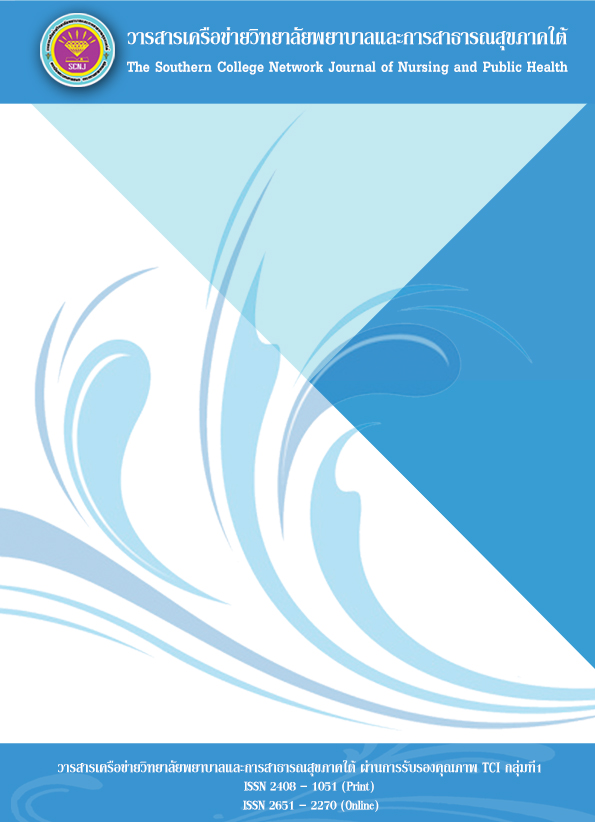ความวิตกกังวล การสนับสนุนทางสังคม และการเข้ามามีส่วนร่วมของบิดา ในผู้จะเป็นบิดาที่มีภรรยาตั้งครรภ์เสี่ยงสูง
คำสำคัญ:
ความวิตกกังวล, การสนับสนุนทางสังคม, การเข้ามามีส่วนร่วมของบิดา, ผู้จะเป็นบิดา, ภรรยาตั้งครรภ์เสี่ยงสูงบทคัดย่อ
การวิจัยเชิงพรรณนาหาความสัมพันธ์นี้มีวัตถุประสงค์เพื่อศึกษาความสัมพันธ์ระหว่างความวิตกกังวล การสนับสนุนทางสังคม และการเข้ามามีส่วนร่วมของบิดาในผู้จะเป็นบิดาที่มีภรรยาตั้งครรภ์เสี่ยงสูง กลุ่มตัวอย่าง คือ ผู้จะเป็นบิดาที่มีภรรยาได้รับการวินิจฉัยว่ามีการตั้งครรภ์เสี่ยงสูง ทั้งทางด้านสูติกรรมและด้านอายุรกรรม และพาภรรยามารับบริการที่แผนกฝากครรภ์ ณ โรงพยาบาลมหาราชนครเชียงใหม่ จำนวน 1,006 ราย เลือกกลุ่มตัวอย่างตามคุณสมบัติที่กำหนดไว้ จำนวน 85 ราย เครื่องมือที่ใช้ในการรวบรวมข้อมูล คือ 1) แบบสอบถามข้อมูลส่วนบุคคล 2) แบบสอบถามการเข้ามามีส่วนร่วมของบิดาที่มีภรรยาตั้งครรภ์เสี่ยงสูง 3) แบบสอบถามความวิตกกังวลขณะเผชิญ และ4) แบบสอบถามการสนับสนุนทางสังคม มีค่าความเชื่อมั่นของแบบสอบถามเท่ากับ .92, .85, และ .84 ตามลำดับ วิเคราะห์ข้อมูลโดยใช้สถิติพรรณนา และสถิติสัมประสิทธิ์สหสัมพันธ์แบบเพียร์สัน ผลการวิจัยพบว่า
1. การเข้ามามีส่วนร่วมของบิดาในผู้จะเป็นบิดาที่มีภรรยาตั้งครรภ์เสี่ยงสูงอยู่ในระดับมาก (M=124.34, SD=06)
2. ความวิตกกังวลมีความสัมพันธ์ทางลบในระดับต่ำกับการเข้ามามีส่วนร่วมของบิดาในผู้จะเป็นบิดาที่มีภรรยาตั้งครรภ์เสี่ยงสูง อย่างมีนัยสำคัญทางสถิติ (r=-.282, p<.01) การสนับสนุนทางสังคมมีความสัมพันธ์ทางบวกระดับต่ำกับการเข้ามามีส่วนร่วมของบิดาในผู้จะเป็นบิดาที่มีภรรยาตั้งครรภ์เสี่ยงสูง อย่างมีนัยสำคัญทางสถิติ (r=.305, p<.01)
ผลการวิจัยครั้งนี้มีข้อเสนอแนะว่า ผู้จะเป็นบิดาที่มีภรรยาตั้งครรภ์เสี่ยงสูงทุกรายควรได้รับการประเมินการเข้ามามีส่วนร่วมของบิดา พยาบาลผดุงครรภ์ควรมีกลยุทธ์ในการลดความวิตกกังวลของผู้จะเป็นบิดา และการสนับสนุนการเข้ามามีส่วนร่วมของผู้จะเป็นบิดาที่มีภรรยาตั้งครรภ์เสี่ยงสูง
เอกสารอ้างอิง
Chemama, N., Sansiriphun, N., & Kantaruksa,K. (2015). Stress, Social Support, and Father Involvement among Muslim Expectant Fathers. Nursing Journal, 42(Supplement), 105-115. (in Thai)
Fenwick, J., Bayes, S., & Johansson, M. (2012). A Qualitative Investigation into the Pregnancy Experiences and Childbirth Expectations of Australian Fathers-to-be. Sexual & Reproductive Healthcare, 3(1), 3-9.doi: 10.1016/j.srhc.2011.11.001
Hernandez, D. C., & Coley, R. L. (2007). Measuring Father Involvement Within Low-Income Families: Who is a Reliable and Valid Reporter? Parenting, 7(1), 69-97. Doi: 10.1080/15295190709336777
House, J. S. (1981). Work Stress and Social Support. Reading, Mass: Addison-Wesley.
Intarasaksith, P. (2007). Husbands' Participation in Maternal Care During Pregnancy and Delivery in Master. (Thesis Submitted to the Faculty of Graduated Studies). Faculty of Demography, Chulalongkorn University. (in Thai)
Johnson Jr, W. E. (2001). Patrenal Involvement among Unwed Fathers. Children and Youth Services Review, 23(6), 513-536.
Kaewkangwan, S. (2010). Psychological Development of All Ages. (9th ed.). Bangkok: Thammasat University Printing House. (in Thai)
Kanjanakeaw, A. (2017). Factors Related to Anxiety of First-Time Fathers. (Thesis submitted to the Faculty of Graduated Studies). Faculty of nursing, Chiang Mai University. (in Thai)
Ketman, P. (2010). The Role of Fatherhood. Retrieved from https://www.si.mahidol.ac.th/
sidoctor/e-pl/articledetail.asp?id=279. (in Thai)
Lamb, M. E. (2000). The History of Research on Father Involvement. Marriage & Family Review, 29(2-3), 23-42.
Lemonda, C. S. T., Kalman, R. K., & Yoshikawa, H. (2009). Father Involvement in Immigrant and Ethnically Diverse Families from the Prenatal Period to the Second year: Prediction and Mediating Mechanisms. Springer Science & Business Media, 60, 496-509. Doi: 10.1007/s11199-009-9593-3
Letourneau, N., Duffett-Leger, L., Dennis, C. L., Stewart, M., & Tryphonopoulos, P. D. (2011). Identifying the Support Needs of Fathers Affected by Post-Partum Depression: A Pilot Study. Journal of Psychiatric and Mental Health Nursing, 18(1), 41-47.
Maloni, J. A., Brezinski-Tomasi, J. E. & Johnson, L. A. (2001). Antepartum Bed Rest: Effect Upon the Family. Journal of obstrics, Gynecological and Neonatal Nursing, 30(2), 165-173.
McCain, G. C., & Deatrick, J. A. (1994). The Experience of High-Risk-Pregnancy. Journal of Obstric, Gynecological and Neonatal Nursing, 23(5), 421-427.
Mckee, L., & O’Brien, M. (1982). The Father Figure. London: Tavistock.
Naewchalee, A. (2007). The Predictability of Personal Factors, Social Support and Uncertainty on Stress and Coping Behavior of First-Time Fathers from High Risk Pregnancy. (Thesis Submitted to the Faculty of Graduated Studies) Faculty of nursing, Mahidol University. (in Thai).
Nuntapong, P. (2015). Factors Related to Father Involvement among First Time Expectant Fathers. (Thesis Submitted to the Faculty of Graduated Studies). Faculty of nursing, Chiang Mai University. (in Thai)
Peplau, H. E. (1989). Interpersonal Theory in Nursing Practice: Selected works of Hildegard E. Peplau: Springer Publishing Company.
Polit, D. F. (2010). Statistic and Data Analysis for Nursing Research (2nd ed.). New Jersey: Pearson Education Inc.
Sansiriphun, N. (2009). Becoming a Firth Time Father among Thais (Unpublished Doctor Dissertation). Chiang Mai University, Chiang Mai, Thailand.
Sansiriphun, N., Kantaruksa, K., Klunklin, A., Baosuang, C., & Jordan, P. (2010). Thai Men Becoming a First-Time Father. Nursing Health Sciences, 12(4), 403-409. doi:10.1111/j.1442-2018.2010.00549.x
Spielberger, C. D. (1976). The Nature and Measurement of Anxiety. In C. D. Spielberger, & R. Diaz-Guerrero (Eds), Cross-Cultural Anxiety (pp. 3-12). Washington: Hemisphere.
Thapinta, D. (1991). Reduction of Anxiety of Staff Nurses Working with AIDS Patients Through Cognitive Reconstructuring and Mindfulness Training. (Thesis Submitted to the Faculty of Graduated Studies). Faculty of Nursing, Chulalongkorn University, Bangkok. (in Thai)
Tongsong, T. (2012). Obstetrics. Bangkok: Luxmirung. (in Thai)
Wiersma, W., & G. Jurs, S. (2009). Research Method in Education an Introduction. (9th ed). Massachusetts: Pearson.
ดาวน์โหลด
เผยแพร่แล้ว
ฉบับ
ประเภทบทความ
สัญญาอนุญาต
1. บทความหรือข้อคิดเห็นใด ๆ ที่ปรากฏในวารสารเครือข่าย วิทยาลัยพยาบาลและการสาธารณสุขภาคใต้ ที่เป็นวรรณกรรมของผู้เขียน บรรณาธิการหรือเครือข่ายวิทยาลัยพยาบาลและวิทยาลัยการสาธารณสุขภาคใต้ ไม่จำเป็นต้องเห็นด้วย
2. บทความที่ได้รับการตีพิมพ์ถือเป็นลิขสิทธิ์ของ วารสารเครือข่ายวิทยาลัยพยาบาลและการสาธารณสุขภาคใต้








